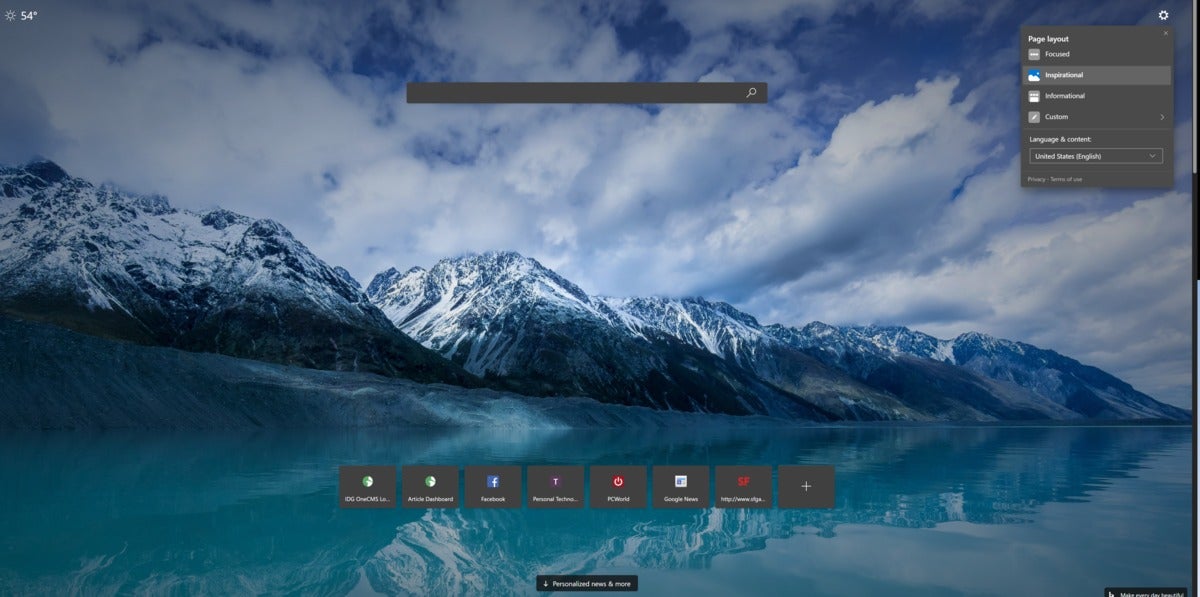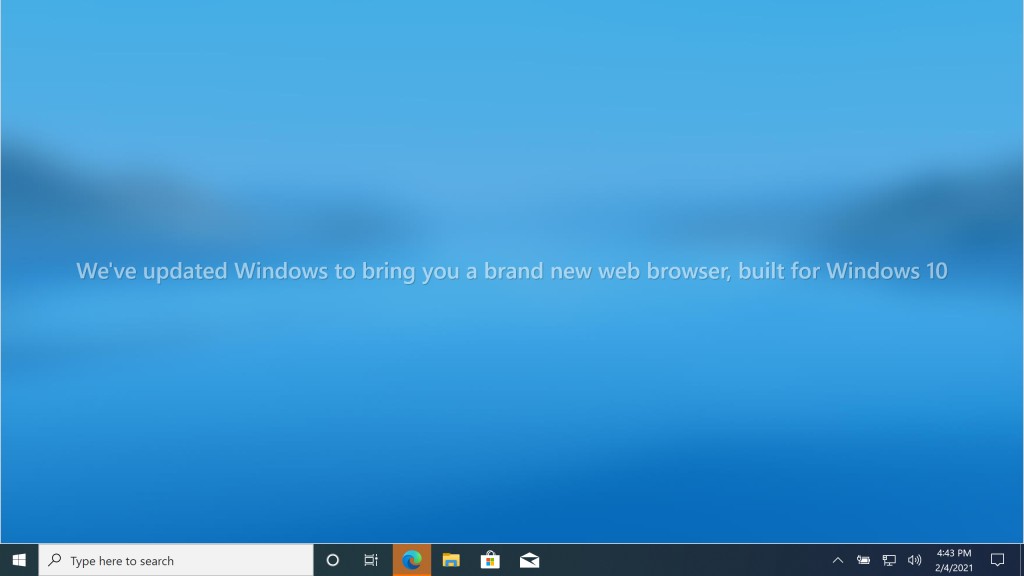UPDATE: Timelines in this post were updated in March 2020 and October 2020 to reflect the best available information.
Jan 15, 2020 The new Microsoft Edge is different; it’s one of the fastest browsers yet. There’s no perceivable lag, and this is the biggest reason you should switch to it. Celebrity Edge® marks a turning point in our approach to ship design. From the very first sketches to experiencing those designs in a virtual reality setting, every step was done in 3-D. From the incredible new Magic Carpet® to the private plunge pools in our new 2-story Edge Villas, we could design the most refined ship at sea. Microsoft’s rebuilt Edge browser is finally here with a modern design, support for Google Chrome extensions, and more. In this guide, we’ll help you download and install the new Chromium. Before the old Edge is deleted, its bookmarks, passwords and some settings are automatically migrated to the new Edge. As for IE, it's staying put. Is Chromium Edge a straight-out clone of Chrome? Jan 15, 2020 In the new version of Microsoft Edge, you can also bring your settings from other web browsers, such as Internet Explorer, Google Chrome, Mozilla Firefox, or settings exported to an HTML file.

HTTPS traffic is encrypted and protected from snooping and modification by an underlying protocol called Transport Layer Security (TLS). Disabling outdated versions of the TLS security protocol will help move the web forward toward a more secure future. All major browsers (including Firefox, Chrome, Safari, Internet Explorer and Edge Legacy) have publicly committed to require TLS version 1.2 or later by default starting in 2020.

Starting in Edge 84, reaching stable in July 2020, the legacy TLS/1.0 and TLS/1.1 protocols will be disabled by default. These older protocol versions are less secure than the TLS/1.2 and TLS/1.3 protocols that are now widely supported by websites:
To help users and IT administrators discover sites that still only support legacy TLS versions, the edge://flags/#show-legacy-tls-warnings flag was introduced in Edge Canary version 81.0.392. Simply set the flag to Enabled and restart the browser for the change to take effect:
Subsequently, if you visit a site that requires TLS/1.0 or TLS/1.1, the lock icon will be replaced with a “Not Secure” warning in the address box, alongside the warning in the F12 Developer Tools Console:
As shown earlier in this post, almost all sites are already able to negotiate TLS/1.2. For those that aren’t, it’s typically either a simple configuration option in either the server’s registry or web server configuration file. (Note that you can leave TLS/1.0 and TLS/1.1 enabled on the server if you like, as browsers will negotiate the latest common protocol version).
In some cases, server software may have no support for TLS/1.2 and will need to be updated to a version with such support. However, we expect that these cases will be rare—the TLS/1.2 protocol is now over 11 years old.
Plays With The New Edge Factor Bundle
Obsolete TLS Blocks Subdownloads
Often a website pulls in some page content (like script or images) from another server, which might be running a different TLS version. In cases where that content server does not support TLS/1.2 or later, the content will simply be missing from the parent page.
You can identify cases like this by watching for the message net::ERR_SSL_OBSOLETE_VERSION in the Developer Tools console:
Unfortunately, a shortcoming in this console notification means that it does not appear for blocked subframes; you’ll need to look in the Network Tab or a NetLog trace for such failures.
Group Policy Details
Organizations with internal sites that are not yet prepared for this change can configure group policies to re-enable the legacy TLS protocols.
For the new Edge, use the SSLVersionMin Group Policy. This policy will remain available until the removal of the TLS/1.0 and TLS/1.1 protocols from Chromium in May 2021. Stated another way, the new Edge will stop supporting TLS/1.0+1.1 (regardless of policy) in May 2021.
For IE11 and Edge Legacy, the policy in question is the (dubiously-named) “Turn off encryption support” found inside Windows Components/Internet Explorer/Internet Control Panel/Advanced Page. Edge Legacy and IE will likely continue to support enabling these protocols via GP until they are broken from a security POV; this isn’t expected to happen for a few years.
IE Mode Details
New Windows Edge
These older protocols will not be disabled in Internet Explorer and Edge Legacy until Spring 2021.
The New Edge has the ability to load administrator-configured sites in Internet Explorer Mode. IEMode tabs depend on the IE TLS settings, so if you need an IEMode site to load a TLS/1.0 website after Spring of 2021, you’ll need to enable TLS/1.0 using the “Turn off encryption support” group policy found inside Windows Components/Internet Explorer/Internet Control Panel/Advanced Page.
If you need to support a TLS/1.0 site in both Edge and IE Modes (e.g. the site is configured as “Neutral”), then you will need to set both policies (SSLVersionMin and “Turn off Encryption Support”).
Thanks for your help in securing the web!
Sky go on sky mobile phone. -Eric
-->This article describes the release cadence and anticipated release schedule for Microsoft Edge.
Korea Post is in charge of postal service, postal banking and insurance services. Its headquarters is in the Gwanghwamun Post Office, near the MIC Building on Sejongno in Seoul. The cyber market place that offer goods or service to the user and trade each other by information technique tool with Korea Post. Boxes (사서함) exist in Korea and they are administered by the local post offices. Mailboxes are usually used by large entities such as corporations, big hospitals or broadcasting companies such as MBC, KBS, or SBS that receive too much mail/packages for mail carriers to handle. Postbox korean drama.
Release cadence
Microsoft provides four options, called channels, to manage how often Microsoft Edge is updated with new features. The Microsoft Edge team plans to push public updates to the Beta and Stable channels every six weeks. For more information about our channels, their release cycle, and support levels, see the Channel overview.
Note
Starting with Stable channel version 94, Microsoft Edge is moving to a 4-week major release cycle cadence. However, we recognize that enterprise customers who manage complex environments need more time to plan and test Microsoft Edge updates. To help our enterprise customers who need an extended timeline to manage updates, Microsoft Edge will offer an Extended Stable option aligned to a longer, 8-week major release cycle; this option will only be available for customers with managed environments.
Release schedule
Telegram twitter sports. The following table lists the planned release dates for the Beta and Stable channels.
Note

Release dates are approximate and might vary based on build status.
Microsoft Edge releases

The following table only tracks and provides information for major releases in both channels.
| Version | Release status | Beta Channel Release week | Stable Channel Release week |
|---|---|---|---|
| 88 | Released Version | 09-Dec-2020 88.0.705.18 | 21-Jan-2021 88.0.705.50 |
| 89 | Released Version | 03-Feb-2021 89.0.774.18 | 04-Mar-2021 89.0.774.45 |
| 90 | Released Version | 16-Mar-2021 90.0.818.8 | Week of 15-Apr-2021 90.0.818.39 |
| 91 | Target release | Week of 27-Apr-2021 | Week of 27-May-2021 |
| 92 | Target release | Week of 08-Jun-2021 | Week of 22-Jul-2021 |
| 93 | Target release | Week of 03-Aug-2021 | Week of 02-Sep-2021 |
| 94 | Target release | Week of 01-Sep-2021 | Week of 23-Sep-2021 |
| 95 | Target release | Week of 28-Sep-2021 | Week of 21-Oct-2021 |
| 96 | Target release | Week of 26-Oct-2021 | Week of 18-Nov-2021 |
| 97 | Target release | Week of 30-Nov-2021 | Week of 06-Jan-2022 |
Release Process
The trigger for Beta and Stable major releases is an equivalent Chromium release.
Progressive rollouts
The date reference (Released/Release week) for the Stable channel references the beginning of the progressive roll out.
We use a progressive rollout model which means that new release availability for any given device could be staggered over upcoming days. For more information, see Progressive rollouts for Microsoft Edge Stable Channel.
See also
